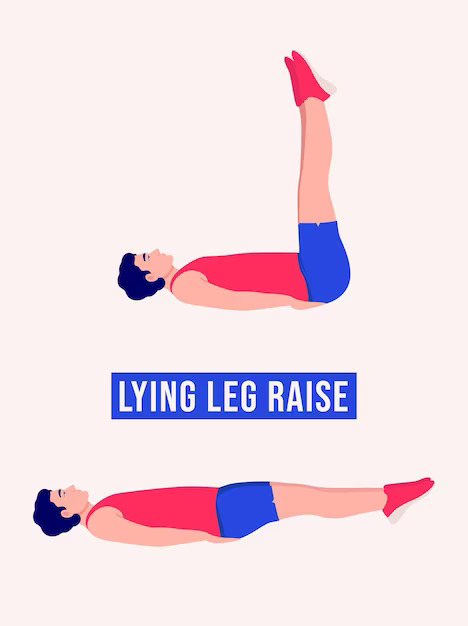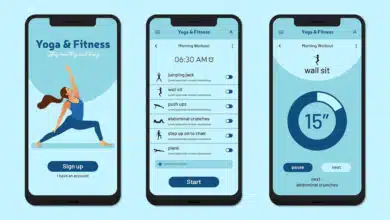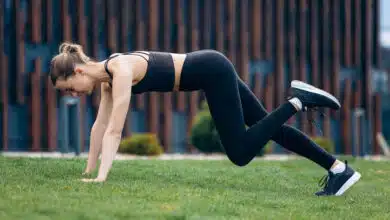Lower Abs Workout

Introduction:
Achieving a toned and defined midsection is a fitness goal for many individuals, and targeting the lower abs is a crucial aspect of attaining that coveted six-pack. While it’s important to remember that spot reduction is not possible, incorporating specific exercises that engage the lower abdominal muscles into your workout routine can help strengthen and tone this area. In this article, we will explore some of the best lower abs workout, helping you to enhance your core strength and achieve a well-rounded physique.
1. Reverse Crunches:
Reverse crunches are a great lower abs workout. Here’s how to perform them and the benefits they provide:
How to Perform Reverse Crunches:
1. Lie flat on your back on an exercise mat or the floor. Place your hands by your sides, palms facing down while extending your legs fully.
2. Bend your knees and lift your legs off the ground, bringing them towards your chest. Your thighs should be perpendicular to the floor, and your knees should be bent at a 90-degree angle.
3. Keeping your abs engaged, exhale and curl your hips off the floor, lifting your legs towards the ceiling. At the top of the movement, your knees should be directly above your hips.
4. Hold the contraction for a second and then slowly lower your legs back to the starting position, maintaining control throughout the movement.
5. Repeat for desired reps.
Benefits of Reverse Crunches:
1. Targets the Lower Abs: Reverse crunches primarily focus on the lower abdominal muscles, including the rectus abdominis and the transverse abdominis. By performing this exercise, you can strengthen and tone your lower abs, helping to create a flatter and more defined midsection.
2. Improves Core Stability: Reverse crunches engage the entire core, including the deep stabilizing muscles. As you lift your hips off the floor, your core muscles work to maintain stability and control the movement, leading to improved core strength and stability.
3. Enhances Posture: Strong lower abs can help improve your posture by supporting the lower back and preventing excessive arching. Reverse crunches can help strengthen the muscles that contribute to a healthy posture, reducing the risk of lower back pain and promoting better alignment.
4. Supports Functional Movements: Having a strong core is essential for performing everyday activities and sports. Reverse crunches target the lower abs, which are crucial for movements like bending, lifting, and twisting. By strengthening these muscles, you can improve your overall functional fitness and reduce the risk of injury during physical activities.
Remember to maintain proper form throughout the exercise and start with a suitable level of difficulty. As your strength improves, you can increase the number of repetitions or progress to more advanced variations of reverse crunches to continue challenging your lower abs.
2. Leg Raises:
Leg raises are a great lower abs workout. Here’s how to perform leg raises correctly:
1. Lie flat on your back on a mat or bench. Place arms by sides while palms facing down for support.
2. Keep your legs straight and together, and extend them fully.
3. Slowly lift your legs off the ground while keeping them straight. Use your lower abs to initiate the movement.
4. Continue lifting until your legs are perpendicular to the floor or as close to that position as possible. Hold this position briefly, engaging your lower abs.
5. Slowly lower your legs back down to the starting position in a controlled manner.
6. Repeat for desired repetitions.

Benefits of Leg Raises:
Here are some benefits of leg raises for the lower abs:
1. Targeted lower ab engagement: Leg raises primarily focus on the lower abdominal muscles, helping to strengthen and tone them.
2. Core stability: This exercise engages your entire core, including the muscles in your abdomen, hips, and lower back. This exercise improves overall core stability and support for your spine.
3. Improved posture: Strengthening the lower abs can contribute to better posture by providing support to the lower back and pelvis.
4. Increased flexibility: Leg raises require a good range of motion in the hip flexors. Regular practice can help improve flexibility in this area.
5. Core strength for other activities: Developing strong lower abs through leg raises can enhance your performance in various sports, exercises, and daily activities that require core stability and control.
Remember to start with proper form and gradually increase the difficulty and intensity as your strength improves.
3. Mountain Climbers:
Mountain climbers are a highly effective lower abs workout that targets multiple muscle groups. Here’s how to perform mountain climbers and the benefits they offer:
1. Starting position: Begin in a high plank position on the ground with your hands shoulder-width apart
while body forming a straight line from head to heels. Your feet should be hip-width apart.
2. Engage your core: Brace your core muscles by pulling your belly button toward your spine. This will help maintain stability throughout the exercise.
3. Alternating leg movements: From the starting position, bend your right knee and bring it towards your chest while keeping your left leg extended. As you do this, switch the position of legs, bringing right leg back and extending your left leg towards your chest.
4. Continuous movement: Continue alternating the movements of your legs in a quick and controlled manner, similar to running in place, but in a horizontal position.
5. Proper form: As you perform mountain climbers, it’s important to maintain a neutral spine and avoid sagging or raising your hips. Your shoulders should be directly above your hands, and your elbows should be slightly bent.
6. Breathing: Breathe steadily throughout the exercise, inhaling and exhaling with each leg movement.
Benefits of Mountain Climbers for Lower Abs:
1. Stronger lower abs: Mountain climbers engage the lower abs to stabilize the core and bring the knees toward the chest. This helps strengthen and tone the muscles in the lower abdominal region.
2. Core stability: The exercise targets the entire core, including the abs, obliques, and lower back muscles. This enhances overall core stability and improves posture.
3. Cardiovascular fitness: Mountain climbers are a dynamic exercise that increases your heart rate and provides a cardiovascular workout. They help improve endurance and burn calories.
4. Full-body engagement: In addition to the lower abs, mountain climbers also engage shoulders, chest and arms muscles.
5. Coordination and agility: Performing mountain climbers requires coordination and agility as you coordinate the movements of your arms and legs while maintaining stability and proper form.
6. Time-efficient workout: Mountain climbers are a highly efficient exercise that can be incorporated into a high-intensity interval training (HIIT) routine or used as a standalone exercise. They provide a challenging workout in a short amount of time.
If you have any pre-existing medical conditions or injuries, it’s always recommended to consult with a healthcare professional before starting a new exercise regimen.
4. Plank Variations:
Plank variations are a highly effective lower abs workout. There are several plank variations that specifically target the lower abs. These variations can help strengthen and tone the muscles in that area.
Here are three effective plank variations for the lower abs:
a) Reverse Plank:
- Sit on the floor and extend your legs in front of you.
- Place your hands on the floor slightly behind your hips with your fingers pointing toward your feet.
- Lift your hips off the ground by pressing with hands while creating a straight line from head to heels.
- Engage your core muscles, including your lower abs, and hold this position for a designated amount of time (e.g., 30 seconds to 1 minute).
- Repeat for multiple sets.
b) Plank Knee Tucks:
- Start in a high plank position. Place your hands under shoulders and body position must be in a straight line from head to heels.
- Bring right knee towards chest while engaging core and maintaining a stable plank position.
- Extend your right leg back to the starting position and repeat the movement with your left knee.
- Continue alternating knee tucks for a designated number of repetitions or time.
c) Side Plank with Hip Dips:
- Start by lying on your side with your forearm resting on the ground and your elbow directly under your shoulder.
- Lift hips off the ground while creating a straight line from head to feet.
- Lower your hips slightly toward the floor and then lift them back up.
- Repeat the hip dips for a designated number of repetitions.
Benefits of Lower Abs Plank Variations:
- Strengthening the lower abs: These plank variations specifically target the lower abdominal muscles, helping to strengthen and tone them.
- Improved core stability: Planks engage the entire core, including the lower abs, which helps improve overall core stability and balance.
- Better posture: Strong lower abs contribute to better posture.
- Enhanced sports performance: A strong core, including the lower abs, is essential for many sports and physical activities, helping with stability, power transfer, and injury prevention.
Remember to maintain proper form and listen to your body during these exercises. If you experience any discomfort or pain, it’s advisable to consult a fitness professional or healthcare provider.
5. Bicycle Crunches:
Bicycle crunches are an effective lower abs workout for targeting the lower abs while also engaging other core muscles. Here’s how to perform bicycle crunches:
1. Lie flat on your back on an exercise mat or the floor. Place your hands lightly behind your head, without pulling on your neck.
2. Lift your legs off the ground and bend your knees at a 90-degree angle. Your thighs should be perpendicular to the floor, and your calves parallel to it.
3. Lift your head, shoulders, and upper back off the ground, engaging your core muscles. This is your starting position.
4. Begin the exercise by simultaneously straightening your right leg and rotating your upper body to the left. Bring right elbow towards left knee.
5. As you twist, keep your left leg bent and lifted off the ground. It should be parallel to the floor.
6. Reverse the movement by straightening your left leg and rotating your upper body to the right, bringing left elbow towards right knee.
7. Continue alternating the twisting motion, mimicking a pedaling motion as if riding a bicycle. Exhale as you twist and bring your elbow to your knee.
8. Aim to perform the exercise in a slow and controlled manner, focusing on engaging your abs throughout the movement.
Benefits of bicycle crunches:
1. Lower abdominal targeting: Bicycle crunches specifically engage the lower abs due to the twisting motion and lifting of the legs.
2. Core strength and stability: This exercise works not only the abs but also the obliques (side abdominal muscles) and the deeper core muscles, helping to improve overall core strength and stability.
3. Flexibility and range of motion: The rotational movement involved in bicycle crunches helps improve flexibility and range of motion in the spine and hips.
4. Calorie burning: Bicycle crunches are a dynamic exercise that involves multiple muscle groups. They can contribute to calorie burning and overall fat loss.
5. Convenience and minimal equipment: Bicycle crunches can be done at home or in the gym with minimal equipment. All you need is an exercise mat or a comfortable surface to lie on.
Conclusion:
Targeting the lower abs is an essential part of achieving a strong and defined core. By incorporating lower abs workout such as reverse crunches, leg raises, mountain climbers, plank variations, and bicycle crunches into your workout routine, you can effectively engage and strengthen your lower abs. Consistency and progressive overload are key, so gradually increase the intensity of your workouts over time. Stay committed, and you’ll be well on your way to sculpting those lower abs and achieving the fitness goals you desire.




